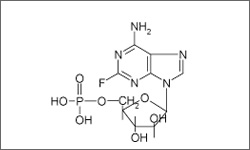Fludarabine

Sale of Fludara has been discontinued in the U.S.
Fludarabine (Fludara®) is used to treat chronic lymphocytic leukemia, non-Hodgkin's lymphoma and cutaneous T-cell lymphoma. Fludarabine is available via oral and intravenous doses, both of which follow the same schedule per month.1
- 1 Chu, E., & DeVita, V. T. (2015). Physicians' cancer chemotherapy drug manual 2015. Burlington, MA: Jones & Bartlett Learning.
Fludura phosphate inhibits DNA synthesis and repair by blocking the activity of two key enzymes required for the process. In turn, this can lead to anti tumor activity against both resting and active cells, which can consequentially lead to apoptosis. Fludarabine (Fludara®) is a strong suppressor of bone marrow activity. It is important to monitor blood cell and platelet counts throughout the duration of treatment.1
The diagram above shows the 3D molecular diagram of Fludarabine.
- 1 Chu, E., & DeVita, V. T. (2015). Physicians' cancer chemotherapy drug manual 2015. Burlington, MA: Jones & Bartlett Learning.
Common side effects include bone marrow suppression, fever and chills, fatigue, infection, nausea and vomiting, weakness. Fludarabine can also lead to immunosuppression, as there is commonly a decrease in t cells found in patients who use the drug. Fludarabine (Fludara®) should not be taken by women who are pregnant and patients should not become pregnant while using this drug, as it may have harmful affects on the developing fetus. It is still unclear if this drug may have effects on fertility after treatment has ended.1
- 1 Chu, E., & DeVita, V. T. (2015). Physicians' cancer chemotherapy drug manual 2015. Burlington, MA: Jones & Bartlett Learning.
Caution should be used in patients with abnormal renal function and elderly patients with previous bone marrow issues. It is also important to monitor patients for signs of infection from treatment.1
- 1 Chu, E., & DeVita, V. T. (2015). Physicians' cancer chemotherapy drug manual 2015. Burlington, MA: Jones & Bartlett Learning.
